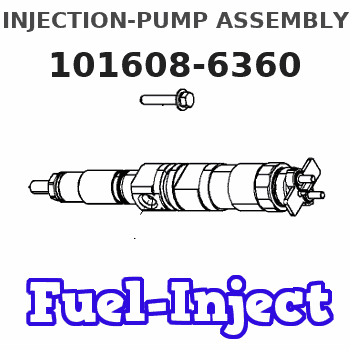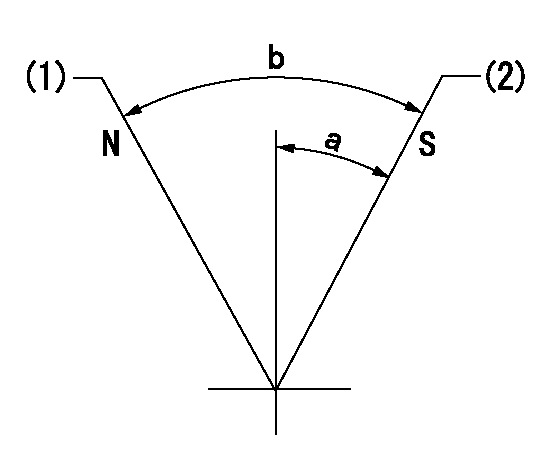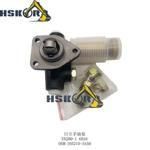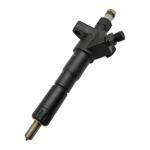Information injection-pump assembly
BOSCH
9 400 619 504
9400619504
ZEXEL
101608-6360
1016086360

Rating:
Service parts 101608-6360 INJECTION-PUMP ASSEMBLY:
1.
_
7.
COUPLING PLATE
8.
_
9.
_
11.
Nozzle and Holder
ME440071
12.
Open Pre:MPa(Kqf/cm2)
17.7{180}
15.
NOZZLE SET
Include in #1:
101608-6360
as INJECTION-PUMP ASSEMBLY
Include in #2:
104749-0493
as _
Cross reference number
BOSCH
9 400 619 504
9400619504
ZEXEL
101608-6360
1016086360
Zexel num
Bosch num
Firm num
Name
Calibration Data:
Adjustment conditions
Test oil
1404 Test oil ISO4113 or {SAEJ967d}
1404 Test oil ISO4113 or {SAEJ967d}
Test oil temperature
degC
40
40
45
Nozzle and nozzle holder
105780-8140
Bosch type code
EF8511/9A
Nozzle
105780-0000
Bosch type code
DN12SD12T
Nozzle holder
105780-2080
Bosch type code
EF8511/9
Opening pressure
MPa
17.2
Opening pressure
kgf/cm2
175
Injection pipe
Outer diameter - inner diameter - length (mm) mm 6-2-600
Outer diameter - inner diameter - length (mm) mm 6-2-600
Overflow valve
131424-5520
Overflow valve opening pressure
kPa
255
221
289
Overflow valve opening pressure
kgf/cm2
2.6
2.25
2.95
Tester oil delivery pressure
kPa
255
255
255
Tester oil delivery pressure
kgf/cm2
2.6
2.6
2.6
Direction of rotation (viewed from drive side)
Left L
Left L
Injection timing adjustment
Direction of rotation (viewed from drive side)
Left L
Left L
Injection order
1-5-3-6-
2-4
Pre-stroke
mm
4.5
4.45
4.55
Beginning of injection position
Governor side NO.1
Governor side NO.1
Difference between angles 1
Cal 1-5 deg. 60 59.5 60.5
Cal 1-5 deg. 60 59.5 60.5
Difference between angles 2
Cal 1-3 deg. 120 119.5 120.5
Cal 1-3 deg. 120 119.5 120.5
Difference between angles 3
Cal 1-6 deg. 180 179.5 180.5
Cal 1-6 deg. 180 179.5 180.5
Difference between angles 4
Cyl.1-2 deg. 240 239.5 240.5
Cyl.1-2 deg. 240 239.5 240.5
Difference between angles 5
Cal 1-4 deg. 300 299.5 300.5
Cal 1-4 deg. 300 299.5 300.5
Injection quantity adjustment
Adjusting point
A
Rack position
11.1
Pump speed
r/min
1050
1050
1050
Average injection quantity
mm3/st.
107.5
106.5
108.5
Max. variation between cylinders
%
0
-2.5
2.5
Basic
*
Fixing the lever
*
Boost pressure
kPa
65.3
65.3
Boost pressure
mmHg
490
490
Injection quantity adjustment_02
Adjusting point
-
Rack position
8+-0.5
Pump speed
r/min
495
495
495
Average injection quantity
mm3/st.
16.5
15
18
Max. variation between cylinders
%
0
-15
15
Fixing the rack
*
Boost pressure
kPa
0
0
0
Boost pressure
mmHg
0
0
0
Remarks
Adjust only variation between cylinders; adjust governor according to governor specifications.
Adjust only variation between cylinders; adjust governor according to governor specifications.
Injection quantity adjustment_03
Adjusting point
E
Rack position
11.3++
Pump speed
r/min
100
100
100
Average injection quantity
mm3/st.
105
105
115
Fixing the lever
*
Boost pressure
kPa
0
0
0
Boost pressure
mmHg
0
0
0
Rack limit
*
Boost compensator adjustment
Pump speed
r/min
375
375
375
Rack position
9.35
Boost pressure
kPa
24
17.3
30.7
Boost pressure
mmHg
180
130
230
Boost compensator adjustment_02
Pump speed
r/min
375
375
375
Rack position
10.4
Boost pressure
kPa
56
53.3
58.7
Boost pressure
mmHg
420
400
440
Timer adjustment
Pump speed
r/min
600
Advance angle
deg.
3
2.5
3.5
Load
0/4
Remarks
Start
Start
Timer adjustment_02
Pump speed
r/min
720
Advance angle
deg.
0.5
Load
0/4
Timer adjustment_03
Pump speed
r/min
(820)
Advance angle
deg.
0
0
0
Load
4/4
Timer adjustment_04
Pump speed
r/min
1000
Advance angle
deg.
1.5
1
2
Load
4/4
Remarks
Finish
Finish
Test data Ex:
Governor adjustment

N:Pump speed
R:Rack position (mm)
(1)Target notch: K
(2)Tolerance for racks not indicated: +-0.05mm.
(3)RACK LIMIT
(4)Boost compensator stroke: BCL
(5)Main spring setting
(6)Set idle sub-spring
----------
K=10 BCL=1.05+-0.1mm
----------
----------
K=10 BCL=1.05+-0.1mm
----------
Speed control lever angle

F:Full speed
I:Idle
(1)Stopper bolt setting
----------
----------
a=18deg+-5deg b=3deg+-5deg
----------
----------
a=18deg+-5deg b=3deg+-5deg
Stop lever angle

N:Pump normal
S:Stop the pump.
(1)Normal
(2)Pump speed aa and rack position bb (to be sealed at delivery)
----------
aa=0r/min bb=1-0.5mm
----------
a=35deg+-5deg b=(55deg)
----------
aa=0r/min bb=1-0.5mm
----------
a=35deg+-5deg b=(55deg)
Timing setting

(1)Pump vertical direction
(2)Coupling's key groove position at No 1 cylinder's beginning of injection
(3)B.T.D.C.: aa
(4)-
----------
aa=8deg
----------
a=(0deg)
----------
aa=8deg
----------
a=(0deg)
Information:
Fig. 5-Output TerminalStart engine and run at approximately 1500 rpm. Connect voltmeter negative lead to alternator ground terminal and connect positive lead to alternator auxiliary terminal (Fig. 4). Voltmeter should read 15.4 volts. Now move voltmeter positive lead to alternator output terminal (Fig. 5). Voltage reading should be 14.4 volts.If voltage at auxiliary terminal is 15.4 volts, while at the output terminal it is 12 volts or battery voltage, the isolation diode is open. Replace it. Test No. 4 - Field Draw Test (Key Switch Off)Detach regulator and let hang by red and black wires. DO NOT allow regulator to touch the output terminal. If test ammeter is not equipped with a 1/4-ohm resistor, a 1/4-ohm resistor should be connected in series with the ammeter to protect the meter.
Fig. 6-Field Terminal - Test 4Disconnect green field wire from field terminal. Connect ammeter from output terminal (2, Fig. 6) to field terminal (1). Current reading should be 2 to 2.5 amps. If less than this, check brushes and slip rings. Test No. 5 - Checking Alternator and Regulator With Regulator Disconnected (Key Switch On - Engine Running)Disconnect the regulator from the connector. Disconnect the green wire from the field terminal. Connect a jumper wire from the output terminal (2, Fig. 6) to the field terminal (1). Connect voltmeter negative lead to ground terminal and connect voltmeter positive lead to regulator terminal (3).Start engine and run at slow idle. This test isolates the defect to either the alternator or regulator.If voltage at regulator terminal rises to 15-16 volts now, when it did not with regulator connected in Test No. 3, then the regulator is defective and should be replaced.If voltage does not rise at regulator terminal and the field circuit was okay in Test No. 4, then the stator or rectifier diodes are defective. See Section 16, Group 1672 for testing diodes and stator. Test No. 6 - Alternator OutputIf not using JDST-23 tong-type ammeter, disconnect wire from alternator output terminal and connect ammeter from alternator output terminal 2, Fig. 6 to starter solenoid "Bat" terminal. Connect voltmeter negative lead to ground and connect positive lead to output terminal (2, Fig. 6). Connect a carbon pile resistor (turned off) to the battery.Run engine at approximately 1400 rpm. Use a master tachometer to measure rpm. Adjust carbon pile to obtain maximum alternator output at 13 to 15 volts. Ammeter should read 25 amps or more for the 35 amp alternator and 43 amps for the 55 amp alternator. Test No. 7 - Testing RegulatorThe regulator must be checked with an alternator that is in good condition. If the alternator is questionable, check it as previously instructed.Connect voltmeter with 0.1 volt accuracy to the alternator output terminal and ground terminal (Fig. 5). With charged batteries and the regulator brought to operating temperature (fifteen minutes operation), the voltage should be as specified for the surrounding air temperature. See chart below. If battery is partially discharged, it may be necessary to connect a

